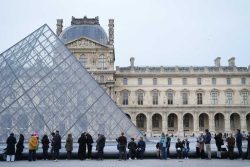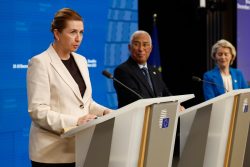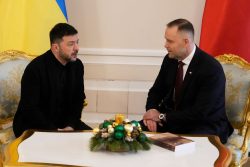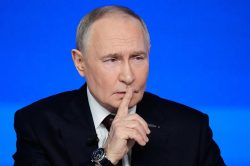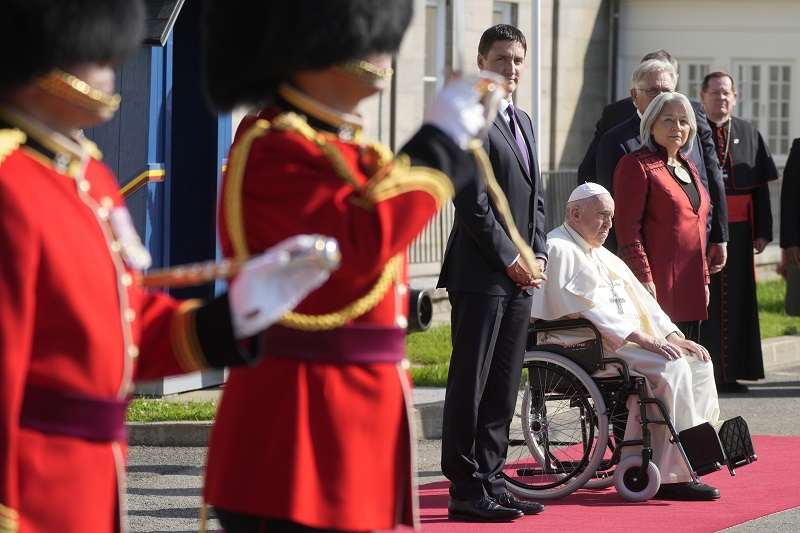
Pope Francis is flanked by Canadian Prime Minister Justin Trudeau, left, and Governor-General Mary Simon, upon his arrival at the Citadelle de Quebec, Wednesday, July 27, 2022.
17:30 JST, July 28, 2022
QUEBEC CITY (AP) — The Canadian government made clear Wednesday that Pope Francis’ apology to Indigenous peoples for abuses in the country’s church-run residential schools didn’t go far enough, suggesting that reconciliation over the fraught history is still very much a work in progress.
The official government reaction came as Francis arrived in Quebec City for meetings with Prime Minister Justin Trudeau and Governor General Mary Simon at her Quebec residence, the hilltop Citadelle fortress, on the second leg of Francis’ week-long visit to Canada.
The government’s criticisms echo those of some survivors and concern Francis’ omission of any reference to the sexual abuse suffered by Indigenous children in the schools, as well as his original reluctance to name the Catholic Church as an institution bearing responsibility.
Francis has said he is on a “penitential pilgrimage” to atone for the church’s role in the residential school system, in which generations of Indigenous children were forcibly removed from their homes and forced to attend church-run, government-funded boarding schools t o assimilate them into Christian, Canadian society. The Canadian government has said physical and sexual abuse were rampant at the schools, with students beaten for speaking their native languages.
Francis on Monday apologized for the “evil” of church personnel who worked in the schools and the “catastrophic” effect of the school system on Indigenous families. In a speech before government authorities Wednesday, Francis apologized anew and blasted the school system as “deplorable.”
Francis noted that the school system was “promoted by the governmental authorities at the time” as part of a policy of assimilation and enfranchisement. But responding to criticism, he added that “local Catholic institutions had a part” in implementing that policy.
Indigenous peoples have long demanded that the pope assume responsibility not just for abuses committed by individual Catholic priests and religious orders, but for the Catholic Church’s institutional support of the assimilation policy and the papacy’s 15th century religious justification for European colonial expansion to spread Christianity.
More than 150,000 Native children in Canada were taken from their homes from the 19th century until the 1970s and placed in the schools in an effort to isolate them from the influence of their families and culture.
Trudeau, a Catholic whose father, Pierre Trudeau, was prime minister while the last residential schools were in operation, insisted that the Catholic Church as an institution bore blame and needed to do more to atone.
Speaking before Francis, he noted that Canada’s Truth and Reconciliation Commission in 2015 had called for a papal apology to be delivered on Canadian soil, but that Francis’ visit “would not have been possible without the courage and perseverance” of survivors of First Nations, Inuit and Metis who travelled to the Vatican last spring to press their case for an apology.
“Apologies for the role that the Roman Catholic Church, as an institution, played in the mistreatment on the spiritual, cultural, emotional, physical and sexual abuse that Indigenous children suffered in residential schools run by the church,” Trudeau said.
The Canadian government has apologized for its role in the school legacy. Former Prime Minister Stephen Harper issued a formal apology over the residential schools in Parliament in 2008, calling them a sad chapter in Canadian history and saying the policy of forced assimilation caused great harm.
As part of a settlement of a lawsuit involving the government, churches and the approximately 90,000 surviving students, Canada paid reparations that amounted to billions of dollars being transferred to Indigenous communities. The Catholic Church, for its part, has paid over $50 million and intends to add $30 million more over the next five years.
Trudeau implied that much more needed to be done by the church, and that while Francis’ visit had “an enormous impact” on survivors, it was but a first step.
Aside from the content of his speech, Trudeau’s remarks broke customary protocol for papal trips. According to diplomatic protocol, only Simon was supposed to address the pope in her capacity as the representative head of state. Simon, an Inuk who is the first Indigenous person to hold the largely ceremonial position governor general, did address Francis.
But the Vatican said Trudeau’s office requested the prime minister be allowed to offer some introductory remarks, a request that arrived in the days before Francis left Rome but after the pope’s itinerary had been finalized and printed.
A senior Canadian government official said Trudeau typically delivers remarks during visits by foreign leaders and that it was important for him to address Canadians during Francis’ visit “particularly given the importance of the matter.” It was, however, added in at the last minute.
Before Francis arrived in Quebec City, Crown-Indigenous Relations Minister Marc Miller said the “gaps” in Francis’ apology could not be ignored.
Echoing criticism from some school survivors, Miller noted that Francis didn’t mention sexual abuse in his list of abuses endured by Indigenous children in the schools. Francis on Monday listed instead physical, verbal, psychological and spiritual abuse. In addition, Miller noted that Francis on Monday spoke of “evil” committed by individual Christians “but not the Catholic Church as an institution.”
Phil Fontaine, a survivor of sexual abuse at the schools and former national chief of the Assembly of First Nations, said the additional reference Wednesday to “local Catholic institutions” went beyond Francis’ original apology and was significant and the closest he could get to apologizing for the entire Church in Canada.
“It reflects the reality that the Catholic Church in Canada is not one institution. It is made up of about 73 different legal institutions, all of which were defendants in the lawsuits,” Fontaine said in a statement.
Francis’ visit has stirred mixed emotions among survivors and their relatives, as well as Indigenous leaders and community members. Some have welcomed his apology as genuine and useful in helping them heal. Others have said it was merely the first step in a long process of reconciliation. Still others have said it didn’t go far enough in assuming responsibility for institutional wrongs dating back centuries.
Francis himself has acknowledged that the wounds will take time to heal and that his visit and apology were but first steps. On Wednesday he committed himself and the local Canadian church to “move forward on a fraternal and patient journey with all Canadians, in accordance with truth and justice, working for healing and reconciliation, and constantly inspired by hope.”
“It is our desire to renew the relationship between the Church and the indigenous peoples of Canada, a relationship marked both by a love that has borne outstanding fruit and, tragically, deep wounds that we are committed to understanding and healing,” he said.
But he didn’t list any specific actions the Holy See was prepared to take.
Trudeau, too, said the visit was a beginning and that reconciliation was the duty of everyone. “It’s our responsibility to see our differences not as an obstacle but as an occasion to learn, to better understand one another and to move to action.”
___
Associated Press religion coverage receives support through the AP’s collaboration with The Conversation US, with funding from Lilly Endowment Inc. The AP is solely responsible for this content.
"News Services" POPULAR ARTICLE
-

American Playwright Jeremy O. Harris Arrested in Japan on Alleged Drug Smuggling
-

Japan’s Nikkei Stock Average as JGB Yields, Yen Rise on Rate-Hike Bets
-

Japan’s Nikkei Stock Average Licks Wounds after Selloff Sparked by BOJ Hike Bets (UPDATE 1)
-

Japanese Bond Yields Zoom, Stocks Slide as Rate Hike Looms
-

Japan’s Nikkei Stock Average Buoyed by Stable Yen; SoftBank’s Slide Caps Gains (UPDATE 1)
JN ACCESS RANKING
-

Keidanren Chairman Yoshinobu Tsutsui Visits Kashiwazaki-Kariwa Nuclear Power Plant; Inspects New Emergency Safety System
-

Imports of Rare Earths from China Facing Delays, May Be Caused by Deterioration of Japan-China Relations
-

University of Tokyo Professor Discusses Japanese Economic Security in Interview Ahead of Forum
-

Japan Pulls out of Vietnam Nuclear Project, Complicating Hanoi’s Power Plans
-

Govt Aims to Expand NISA Program Lineup, Abolish Age Restriction


